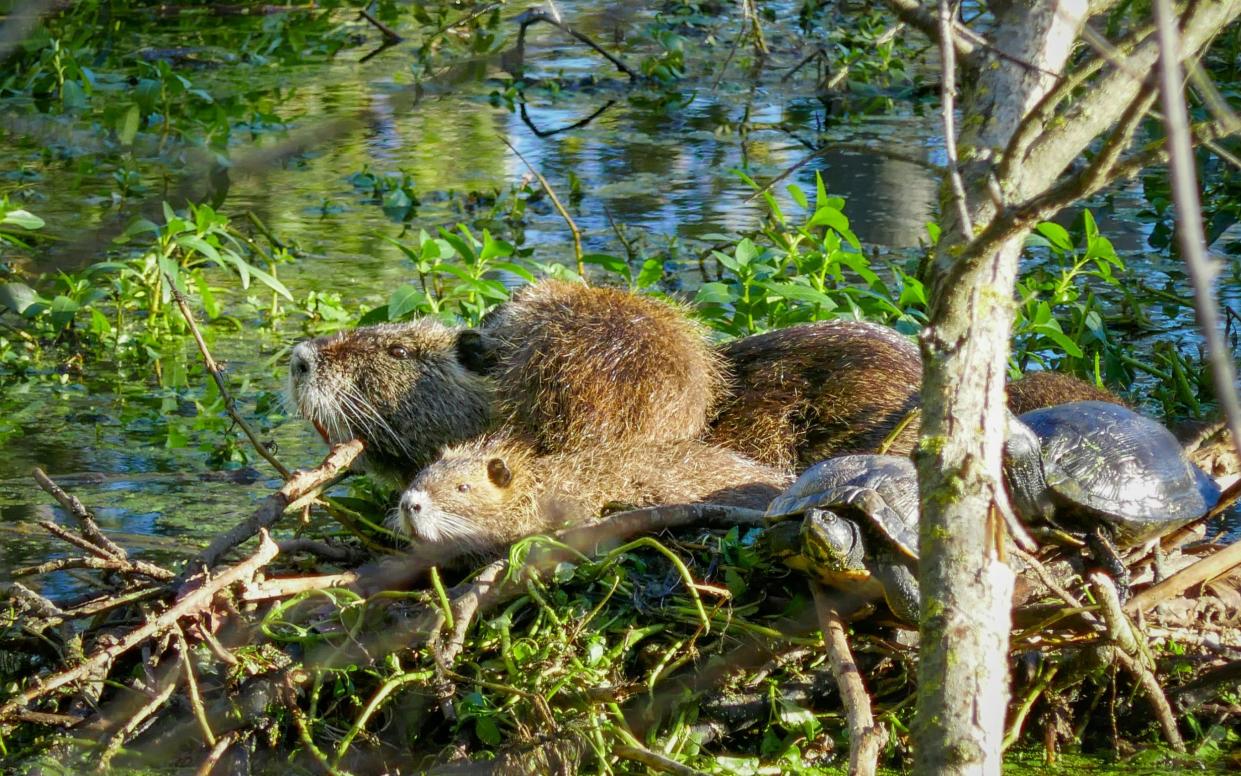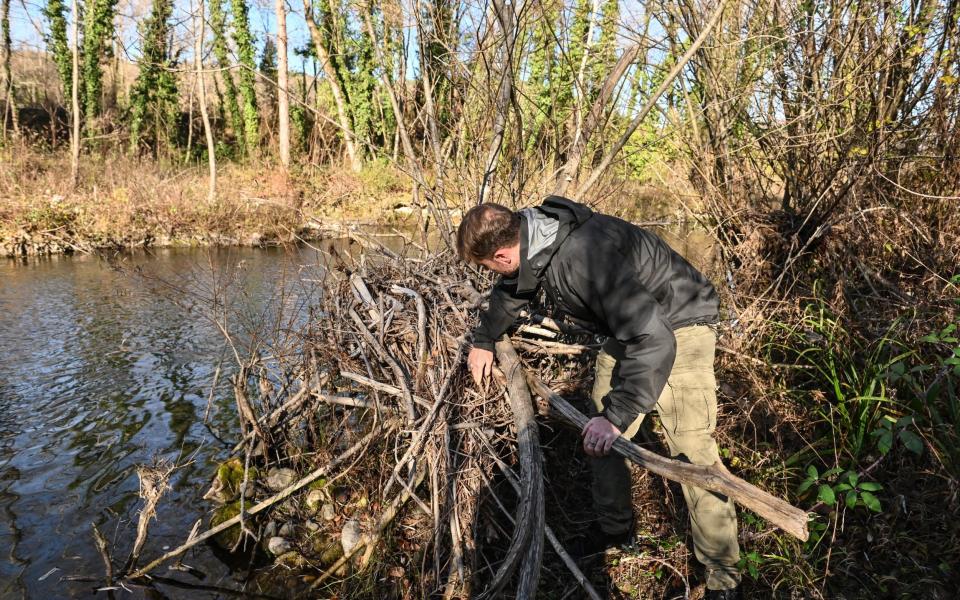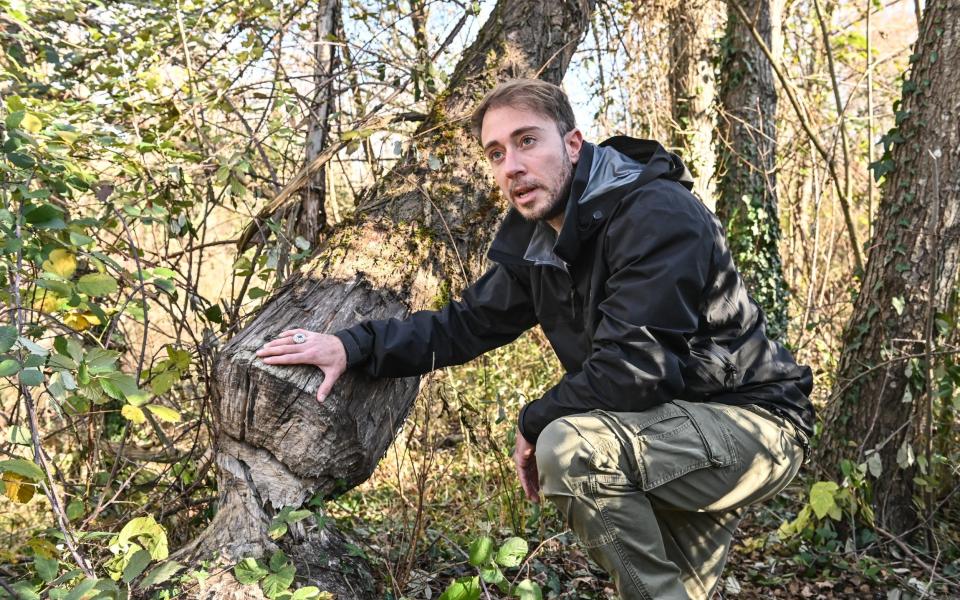Battle of the ‘beaver believers’ breaks out in Italy as species mysteriously reintroduced

Alessio Bariviera kneels down at the base of a fallen tree, its tapered trunk bearing the tell-tale incision marks of powerful teeth belonging to a new arrival in the woods and wetlands of Tuscany: the beaver.
Five hundred years after the species was driven to extinction in Italy by hunting, they are back.
All along a stretch of the Tiber River in this part of Tuscany, tree trunks have been gnawed and felled.
“They can take down even bigger trees than this,” said Mr Bariviera, a conservationist and fellow of the Royal Geographical Society. “They are truly engineers of the ecosystem. They love this kind of riparian forest and slowing-flowing water.”
Released illegally
The reintroduction of the beavers is not the culmination of scientific assessments and public consultations. Instead, they have been released illegally.
Mystery surrounds exactly who is behind the covert campaign of reintroduction, which has been dubbed “guerrilla rewilding”.
Whoever they are, they have gone to considerable trouble: acquiring beavers from abroad, perhaps in Germany or Austria or Scandinavia, transporting them secretly for hundreds of miles into Italy and then releasing them into rivers, streams and swamps, all the while being careful not to get caught for what is considered by the law to be an illegal act. Similar covert releases of beavers have taken place in Britain, Spain and Belgium.
‘Beaver believers’
“We call them ‘beaver believers’,” said Mr Bariviera, who works as a photographer and film producer. He is making a film about what he calls “the beaver squad” and its guerrilla rewilding operations.
“They are returning beavers to their former range. They feel they have the right to do it, for the greater good.”

The beaver believers are reluctant to be identified and declined to be interviewed.
But in a brief statement they said they were attempting to “right the wrongs of the past and bring life back to our ravaged and depleted waterways using the best natural processes available to us.”
First beavers introduced to Italy in 2020
It is thought the first beavers were introduced to two sites in central Italy in 2020. Since then, the animals have spread rapidly to several other regions, from Lombardy in the north to Campania, Molise and Abruzzo to the south.
A battle of the beavers has now broken out between the activists who are releasing them into the wild and government officials and scientists.
Proponents of reintroduction say the Eurasian beaver is native to Italy and has every right to be there.
Pushed to extinction by hunting
The beaver was common in Italy until it was pushed to extinction about five centuries ago by hunting for its fur and castoreum – a musky secretion from the animal’s scent glands which was used as perfume and for medicinal properties.
Its supposed powers of healing were documented by Hippocrates, the ancient Greek physician.
Conservationists say beavers bring huge benefits for the ecosystem. By building lodges – homes made of sticks and branches – and dams, they regulate the flow of water and reduce the risk of flooding during heavy rain. Their dams act as a filter, cleaning river water as it passes through. Their engineering efforts create ponds which provide habitat for fish, insects and other mammals. In the central Italian region of Abruzzo, for instance, otters are thriving in areas colonised by beavers.
“As beaver numbers increase, biodiversity rises – and we desperately need biodiversity,” said Mr Bariviera.
But government scientists and regional authorities take a different view.
Dangerous president
They say the guerrilla reintroduction of beavers could set a dangerous precedent, encouraging other activists to release other species.

If animals are to be reintroduced to their former range, it needs to be done with care and consultation, experts argue citing the example of when brown bears from Slovenia were brought to northern Italy in the 1990s after an absence of decades.
Piero Genovesi, a senior scientist at the government agency ISPRA, the Higher Institute for Environmental Research and Protection, worked on the bear reintroduction programme. “You have to listen to local communities. You need to carry out surveys to understand what people think. There needs to be the right conditions for a species to be reintroduced. The scientific community is against illegal reintroductions. It is a very extreme vision of rewilding.”
Beavers removed from wild
Scientists at ISPRA have advised the Italian authorities that the beavers should be removed from the wild as soon as possible.
“It’s feasible. The number of beavers is not very high, they tend to stick close to water sources, and there is plenty of knowledge about how to trap them. It would not be very difficult. But it depends on the resources that regional governments want to devote. The longer you wait, the more challenging and more expensive it will be,” said Prof Genovesi.
Claudio Barbaro, undersecretary at the ministry of agriculture, said earlier this year that the presence of beavers in central Italy was the result of “releases of an illegal nature ... and as such must be removed in accordance with the law.”
It is now up to regional governments to decide how to intervene.
Beaver champions are trying to fight the plan. In September, a coalition of conservation groups wrote to the director of biodiversity at the European Commission, arguing that the beavers should stay.
“Eurasian beavers have always been a part of Italian ecology, history, and heritage, and are by definition a native species,” they wrote.
‘Infringement’
The conservation organisations argued that the proposed eradication of the beavers would be “an infringement not only of national legislation, but also of obligations deriving from EU law.”
The letter was signed by Edward Cutler, a British conservationist who has a small farm in Tuscany and is president of the Tuscany Environment Foundation, an environmental NGO.
“There’s not a single biologist or ecologist I have met who laments the return of the beaver in any river system in Europe. They have a hugely positive impact on the environment. Their ability to store water by building dams is particularly important in a Mediterranean country like Italy where water is going to become more and more precious.”
Beavers should be valued
He said that while he respects the stringent controls that are normally required to reintroduce a species, now that beavers are here, they should be valued.
“Rather than talking about eradicating them, I think the approach should be to acknowledge they are out there and to prepare people for any potential conflicts in the future.”
Mr Bariviera is sceptical that Italian authorities will get their act together in time to eliminate beavers from the wild.
He said: “Regional and national authorities in Italy are not very good at collaborating. The likelihood of getting rid of the beavers? Zero.”
To make the challenge for the authorities greater, he suspects the beaver believers are planning new reintroductions in other parts of Italy.


